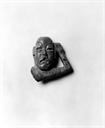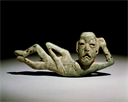Description
Objects have curious ways of travel through space and time before ending up in museums and private collections. This particular pendant came to Dumbarton Oaks in two pieces, several years apart. Broken across the shoulders, the bust of the figure came first, followed later by the lower part of the body including the right arm, the torso, and both legs.
A tour de force of Olmec lapidary work, this pendant is sculpted out of a single piece of serpentine with metallic inclusions. It depicts a male reclining on his left side, with his left arm placed against his sharply upturned head. The position of both arms and legs and the presence of hollowed spaces in between them suggest that it was meant to be worn horizontally, suspended from some sort of string or cord.
Attention to detail is apparent. Fine incised lines delineate the fingers, toes, and buttocks, and even finer lines are used to indicate details of the ears and the loincloth worn by the personage. Deeper carving is seen in the rendering of the mouth, nostrils, and eyes. The sharply down-turned mouth, characteristic of Middle Formative Olmec art, may be related to a jaguar maw and suggest a supernatural state of being. The perforations in the earlobes would have allowed for the suspension of ornaments.
Other reclining figures are known from the Olmec culture, but it is difficult to state with precision what such a posture might imply. Some scholars have suggested that these figures are flying or floating, and they represent the trance shamans experience after consuming hallucinogens. The jaguar maw may indicate the figure was in the throes of a supernatural trance.
Bibliography
Anonymous 1958 A Collection of Pre-Columbian Fine Art (Review Article of the 1957 Catalogue). Natural History LXVII (3). p. 132.
Benson, Elizabeth P. 1963 Handbook of the Robert Woods Bliss Collection of Pre-Columbian Art. Dumbarton Oaks, Trustees for Harvard University, Washington, D.C., p. 5, cat. 18.
Benson, Elizabeth P. 1981 Some Olmec Objects in the Robert Woods Bliss Collection at Dumbarton Oaks. In The Olmec and Their Neighbors: Essays in Memory of Matthew W. Stirling, Elizabeth P. Benson, ed., pp. 95-108. Dumbarton Oaks Research Library and Collections, Trustees for Harvard University, Washington, D.C., p. 99, fig. 3.
Benson, Elizabeth P. and Beatriz de la Fuente (EDS.) 1996 Olmec Art of Ancient Mexico. National Gallery of Art; Washington, D.C., p. 220, cat. 58.
Bernal, Ignacio 1968 El Mundo Olmeca. 1. ed. Editorial Porrúa, México. pl. 98c.
Bernal, Ignacio 1969 The Olmec World. University of California Press, Berkeley. pl. 74c.
Bernal, Ignacio 1991 El Mundo Olmeca. 2. ed. Editorial Porrúa, México. p. 210, pl. 98c.
Bliss, Robert W. 1957 Pre-Columbian Art: The Robert Woods Bliss Collection. Text and Critical Analyses by S. K. Lothrop, Joy Mahler and William F. Foshag. Phaidon, New York. p. 234, cat. 12, pl. VI.
Bliss, Robert W. 1959 Pre-Columbian Art: The Robert Woods Bliss Collection. 2nd ed. Text and Critical Analyses by S. K. Lothrop, Joy Mahler and William F. Foshag. Phaidon, London. p. 242, cat. 12, pl. VI.
Bühl, Gudrun (ED.) 2008 Dumbarton Oaks: The Collections. Dumbarton Oaks Research Library and Collection, Washington, D.C., p. 230-1.
Christensen, Erwin Ottomar 1955 Primitive Art. Bonanza Books, New York. p. 186, 232, fig. 167.
Coe, Michael D. 1965 The Olmec Style and Its Distributions. In Handbook of Middle American Indians; V. 2-3: Archaeology of Southern Mesoamerica, Gordon Randolph Willey, ed. University of Texas Press, Austin. p. 744, fig. 11.
Davies, Nigel 1983 The Ancient Kingdoms of Mexico. Pelican Series. Penguin Books, New York. fig. 4.
Disselhoff, Hans Dietrich and Sigvald Linné 1960 The Art of Ancient America: Civilizations of Central and South America. Art of the World, Non-European Cultures: The Historical, Sociological and Religious Backgrounds. Crown Publishers, New York. p. 64, fig. 38.
Glubok, Shirley 1968 The Art of Ancient Mexico. Harper & Row, New York. p. 24.
González Calderón, O. L. 1991 The Jade Lords. O.L. González Calderón, Coatzacoalcos, Ver., pl. 468.
Magni, Caterina 2003 Les Olmèques: Des Origines Au Mythe. Editions Seuil, Paris. p. 65.
Martí, Samuel 1961 Canto, Danza Y Música Precortesianos. [1. en español] ed. Fondo de Cultura Económica, México. p. 155, fig. 77.
Niederberger, Christine 1987 Paléopaysages Et Archéologie Pré-Urbaine Du Bassin De México (Mexique). 1re ed. Etudes Mésoaméricaines, V. 11. Centre d'Etudes Mexicaines et Centraméricaines, México. fig. 89.
Stirling, Matthew W. 1961 The Olmecs, Artists in Jade. In Essays in Pre-Columbian Art and Archaeology, Samuel Kirkland et al Lothrop, ed., pp. 507. Harvard University Press, Cambridge. p. 50, fig. 4.
Stuart, George E. 2001 Ancient Pioneers: The First Americans. National Geographic Society, Washington, D.C., p. 124.
Taube, Karl A. 2004 Olmec Art at Dumbarton Oaks. Pre-Columbian Art at Dumbarton Oaks; No. 2. Dumbarton Oaks Research Library and Collection, Washington, D.C., p. 164-8, pl. 35.
Willey, Gordon Randolph 1966 An Introduction to American Archaeology, Vol. 1: North and Middle America. Prentice-Hall Anthropology Series. Prentice-Hall, Englewood Cliffs, N.J., p. 101, fig. 3-28a.
Exhibition History
"Indigenous Art of the Americas", National Gallery of Art, Washington DC, August 1949 to July 1962.
"Olmec Art of Ancient Mexico", National Gallery of Art, Washington DC, 6/30 - 10/20/1996.
Washington, DC. Dumbarton Oaks, "75 Years/75 Objects: Celebrating 75 Years of the Dumbarton Oaks Museum," September 8, 2015 - May 22, 2016.







